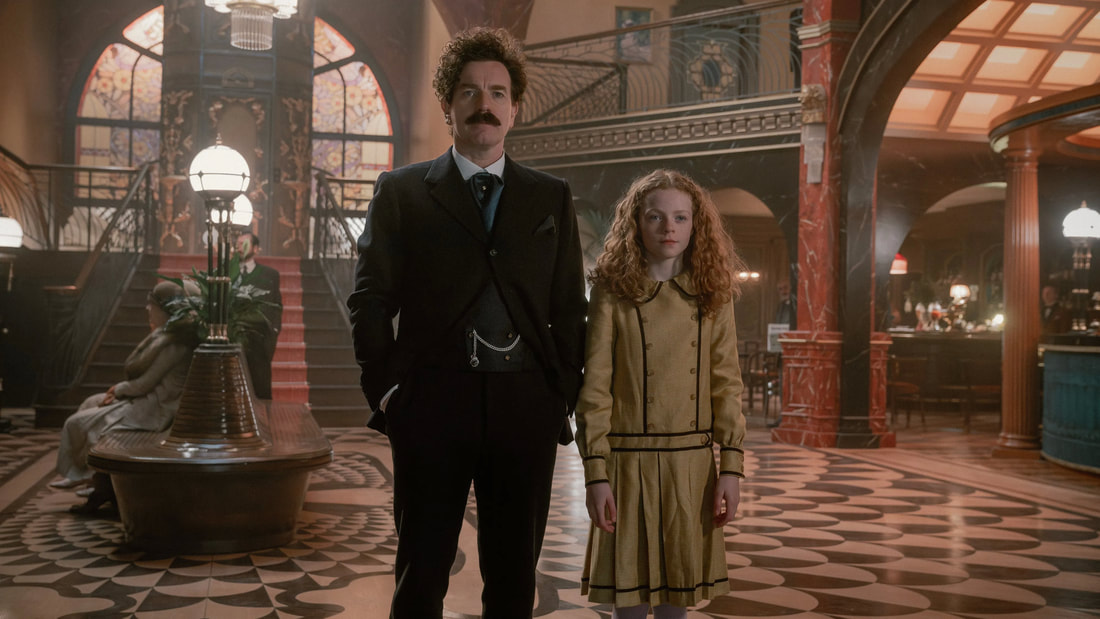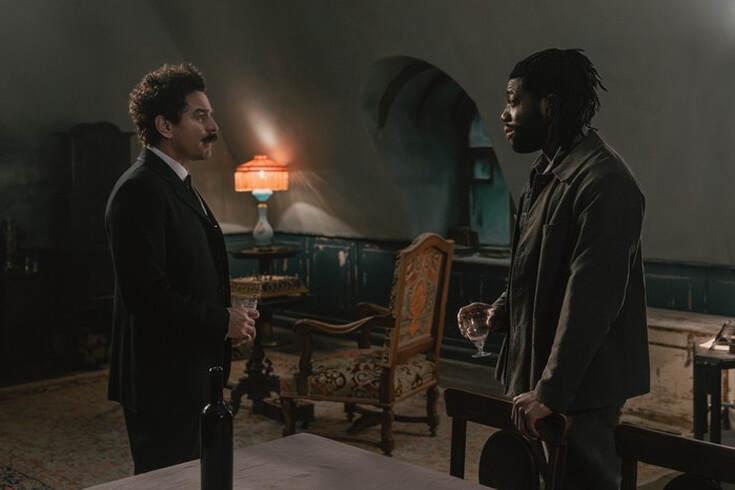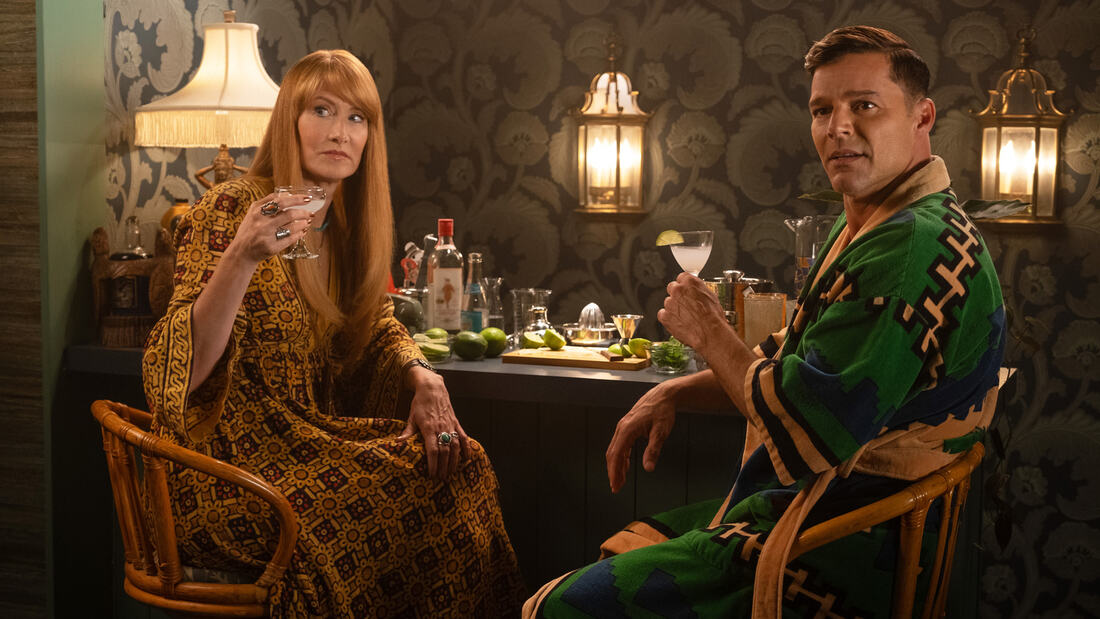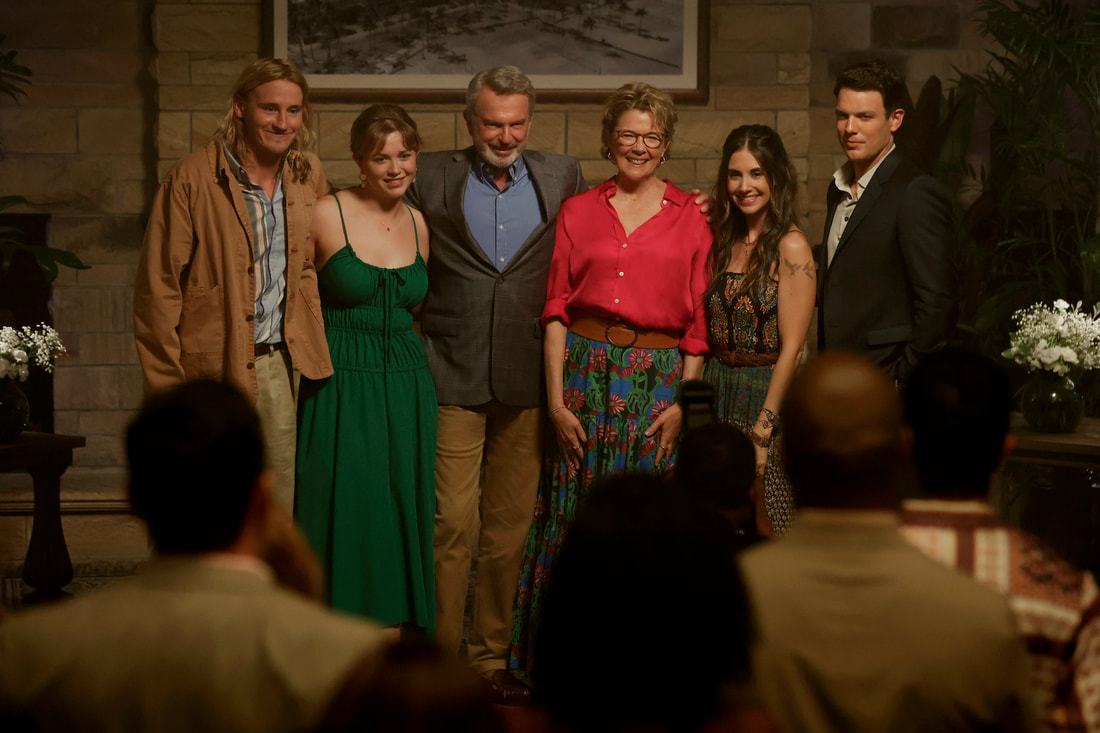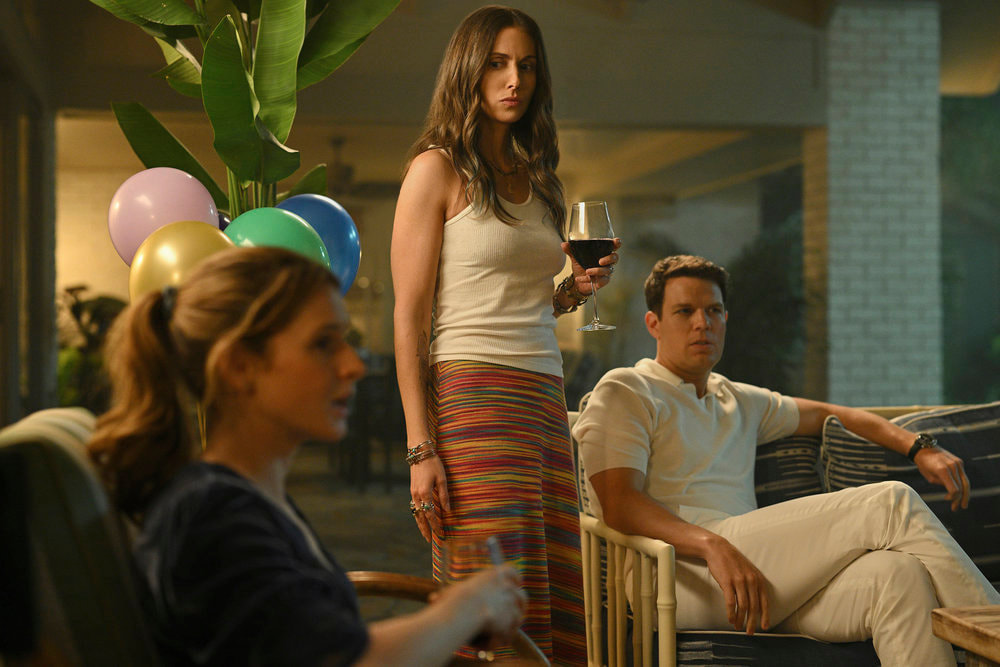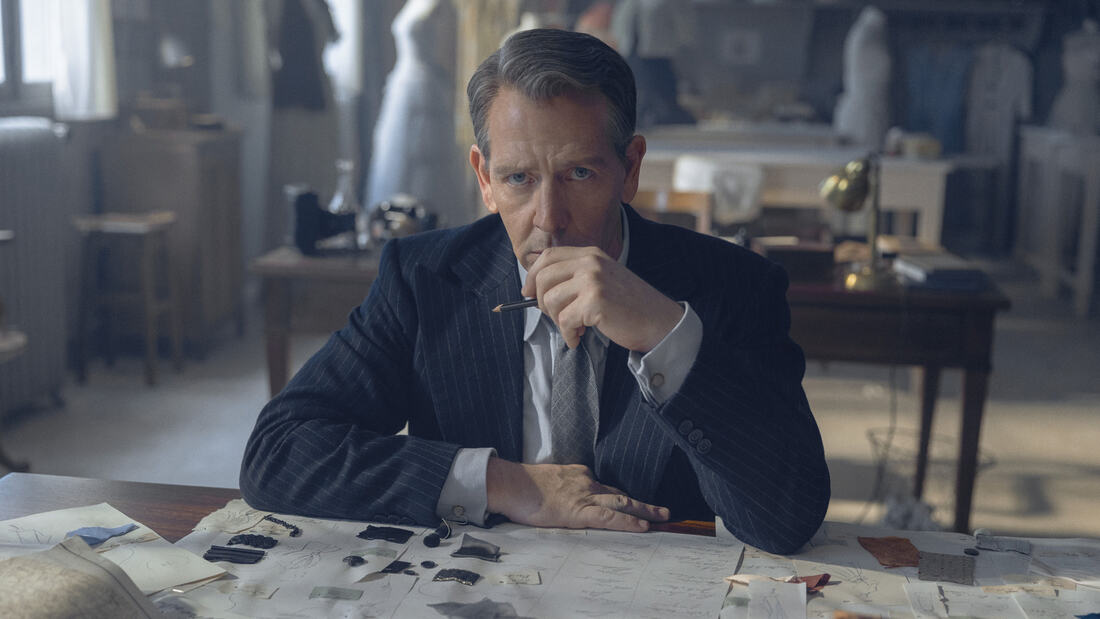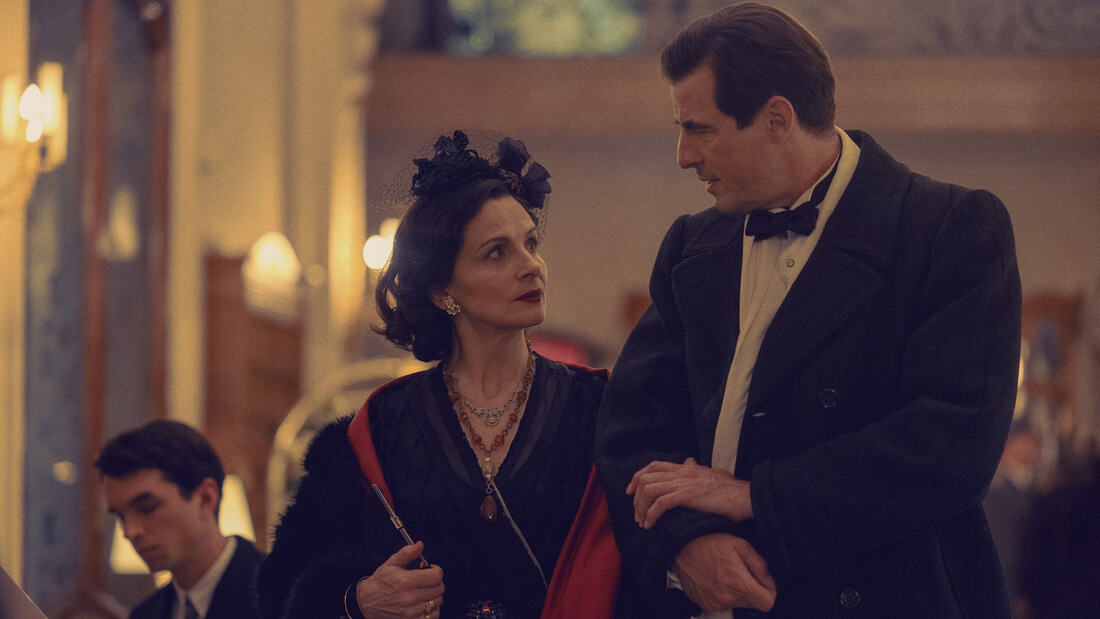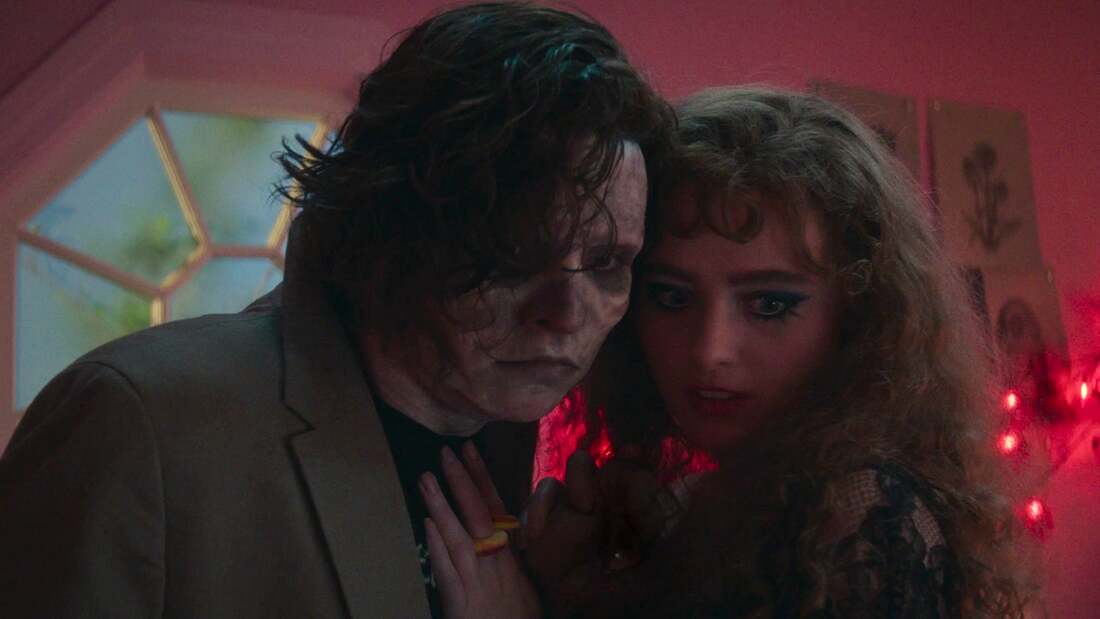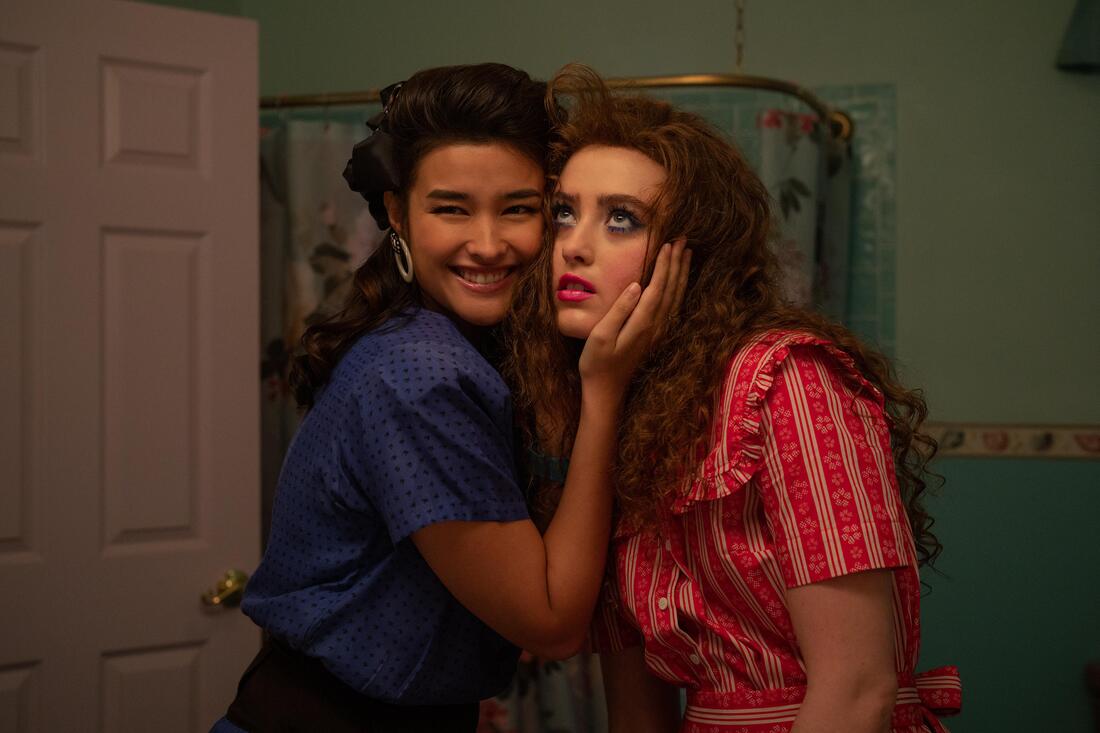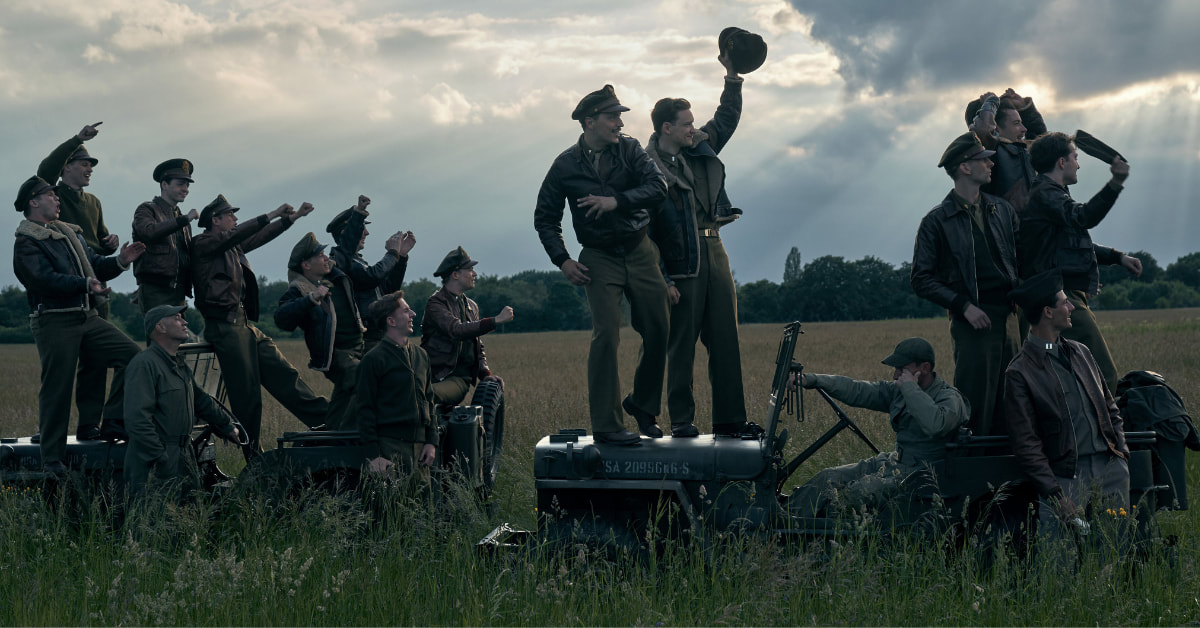|
Review by Tatiana Miranda The best way to describe Nicholas Colia's Griffin in Summer is Theater Camp meets Rushmore meets Aristotle and Dante Discover the Secrets of the Universe. The movie centers around the titular Griffin, a 14-year-old aspiring playwright who is a bit of a jaded writer. His latest work, Regrets of Autumn, is described by Griffin as Who's Afraid of Virginia Woolf? meets American Beauty and centers around the downfall of a marriage. It's heavy stuff for a 14-year-old, but as the movie progresses and we meet Griffin's miserable mother, portrayed by Melanie Lynskey, and learn about his increasingly absent father, it makes sense why he would choose to base his play on such a subject matter. Although Griffin's plays might be a bit depressing, the film is anything but that. After alienating himself from his peers and long-time collaborators, Griffin meets Brad, an attractive 20-something handyman and former performance artist from New York City. While it isn't instant infatuation, Griffin quickly begins to look up to Brad and his former life in New York and discovers more about his burgeoning sexuality as he develops a crush on Brad. While it's no controversial queer romance like Call Me by Your Name, it is more of a comedic and heartfelt coming-of-age that focuses on growing up as someone a little unordinary through both their sexuality and interests. While Griffin in Summer can be a bit campy at times, it is ultimately a funny and relatable look at discovering yourself as a teenager. Incredible performances bring the story to life, with Everett Blunck portraying a standoffish yet passionate Griffin. His usual creative partner, Kara, is effectively played by Abby Ryder Fortson, best known for her role in Are You There God? It's Me, Margaret. Even Brad's over-the-top girlfriend, portrayed by Kathryn Newton, is a comedic scene-stealer. While each character seems to fall into specific tropes to service Griffin's growth, it doesn't feel inauthentic or one-dimensional. Even though the movie centers on Griffin, each character is unique and well-developed while not taking too much attention away from the titular character and his arc. Because of Griffin's niche interest, his passion for his art differs greatly from his peers, who would rather spend the summer at parties or, for Kara, with her new boyfriend than spend hours practicing for an amateur play. While these secondary characters might just as easily have been played off as pawns to signal Griffin's loneliness and disconnect, instead, they also have their individual stories of growth and change. Lynskey's performance as Griffin's mom is, although understated, a great insight into what makes Griffin the way he is while also establishing her individuality as a character.
Although Griffin in Summer is not necessarily groundbreaking in terms of coming-of-age films, it is a wholesome and relatable story about growing up and not fitting in. Griffin's solace in his art and dreams about moving to New York is something that most young, queer creatives in suburbia can relate to, and Brad's setbacks as an artist are also familiar to those who have followed their passions into adulthood. Griffin in Summer premiered at the 2024 Tribeca Festival, which ran from June 5-16 in New York City. Rating: 4/5
0 Comments
Review by Tatiana Miranda Most recognizable from his leading role in Disney's Sky High, Michael Angarano has recently gained more notoriety for his roles in films such as Oppenheimer. Now, he stars in his sophomore film as director and writer, Sacramento. Co-written with Chris Smith, the movie follows Angarano's character, Ricky, as he grapples with his father's death and reminisces on past relationships. Alongside Angarano, the film stars Maya Erskine, Kristen Stewart, and Michael Cera as Ricky's old friend Glenn. While the movie might initially seem like a classic buddy road trip comedy, it attempts to tackle deeper subjects, such as fatherhood and relationships.
Sacramento opens with a meet-cute between Ricky and Erskine's character, Tallie. The film quickly shifts its focus away from them as we see Ricky in a rehab center following the death of his father. A know-it-all who tends to project his issues onto others, he finds himself visiting Glenn, who is hesitant about Ricky's reappearance and incredibly stressed about his impending fatherhood, which he tries to hide from Ricky. After an uncomfortable lunch together, Ricky lies and guilts Glenn into traveling from LA to Sacramento. By the end of the trip, the two have made amends and made strides in their respective romantic relationships. Like Angarano's directorial debut, Avenues, Sacramento is an awkward and understated emotional comedy. But Ricky's unlikable and untrustworthy personality, mixed with Glenn's uncomfortable and extreme behaviors, make the film too awkward for its own good. While the movie tries to show the nuances of the beginnings of fatherhood, it feels a bit cartoonish as we see Glenn have a mental breakdown due to the stress of becoming a first-time dad. Mirrored is the equally neurotic Ricky as he tries to make amends with those he ignored following his dad's death. Kristen Stewart also plays a similarly one-dimensional character as the stoic wife to Glenn. Every character acts a bit too outlandish for the audience to be able to empathize with them or understand their emotional state beyond quick gags. As a rare road trip comedy, Sacramento has the potential to be an interesting story about grieving a parent while also becoming one for the first time, but Ricky's loss is more of a driving force for the plot rather than a way to gain insight into the character's delay in becoming a father. In fact, not much is discussed when it comes to his dad or the relationship they shared, but instead, the act of his death is more what Ricky uses as an excuse for his behavior. With a film with so many different relationships, both on- and off-screen, hardly any of them feel like authentic and wholesome depictions. Glenn and his wife are opposites, and they are so comical that it makes it hard to picture them as a real, functional couple. Meanwhile, Ricky and Glenn's relationship is not given enough depth and chemistry to account for the years that they supposedly spent as close friends. Although Sacramento has its moments, such as the gorgeous cinematography and funny interactions between characters, it feels too distant to leave a lasting emotional impression. With a film as understated as this one, the flaws outweigh any potential merit the movie may have. Sacramento premiered at the 2024 Tribeca Festival, which ran June 5-16 in New York City. Rating: 2/5 Review by Tatiana Miranda For many, Mars might seem like just another adult animated movie, but for those familiar with the comedy troupe The Whitest Kids U'Know and their sketch comedy series of the same name, it's the latest and last collaboration of the group following the end of the series in 2011 and leader Trevor Moore's death in 2021. The group had been working on Mars since 2012 and shifted it from an originally live-action film to an animated one. Even with all of the changes over the years, Zach Cregger, one of the filmmakers and members of the troupe, ensures that the final film is what Moore had envisioned. Drawn in a crass and simple hand-drawn style, Mars isn't anything revolutionary when it comes to adult animation in terms of visuals. Even the film's humor, while entertaining, does pander to a specific audience, that audience being long-standing fans of the troupe. Inside jokes from the group's crowdfunding campaigns make an appearance, and the film makes understated yet topical commentary on the extremities of wealth and the boredom of billionaires like Elon Musk and Jeff Bezos. Yet, the film doesn't hold a lot of depth beyond being an homage to Moore and The Whitest Kids U'Know. Since most of the group's comedy experience comes from their sketch series, it makes sense that the movie feels more like a series of sketches rather than a full feature-length film. Between the over-the-top characters and the unreal situations they find themselves in, the movie isn't lacking in comedy and is one of the things that the movie excels at. Yet, out of all of the adult animated series and films out these days, Mars doesn't stand out as the plot, and some of the characters, such as the main one, Kyle Capshaw, voiced by Cregger, feel a bit one-dimensional, even when they try not to be. The film opens as Capshaw decides to abandon his overbearing fiance and father-in-law's dentist practice to start a new life on Mars. Alongside him on Mars are an adult kidnapping survivor, a religious fanatic, and a teacher, along with billionaire Elron Branson, who organized the trip to colonize the planet. With a very caricature-like cast of characters, it would make sense for the film to lean into the absurdity similar to popular adult animations such as Rick and Morty and Smiling Friends. Yet, it attempts to give the characters arcs to mixed results. With Capshaw's crisis that landed him on Mars, a narrative arc would make sense as he attempts to return home, but any growth or personality given to the character is quickly interrupted by one of the film's many gags.
While Mars might not necessarily work as its own entity, it is a testament to the comedic style and fanbase that The Whitest Kids U'Know has spent so many years establishing. Even though it marks the end of the troupe's collaboration, it is a well-earned culmination of the group's humor and the evolution of the film since its inception in 2012. Mars premiered at the 2024 Tribeca Festival, which ran from June 5-16 in New York City. Rating: 2.5/5 Review by Tatiana Miranda Bad Actor: A Hollywood Ponzi Scheme sets out to tell the story of Zach Horwitz, a D-list actor under the name of Zach Avery, who was arrested in 2021 for creating a Ponzi scheme that garnered around $650 million. After being sentenced to 20 years in prison, Horwitz's story was well publicized, although the details of his life and lies hadn't been explored in as much depth as this film showcases. While Bad Actor might appear to be your average true crime documentary at first glance, just like Horwitz, there is more that lies beneath the surface. The film starts from the beginning, with the filmmakers traveling to Horwitz's hometown in Indiana, where they trace his high school football career to his time in college studying psychology and then his brief stint as a health food restaurateur. As they follow his history, they unravel discrepancies in what he's told the press, friends, and investors. As is shown in the documentary, Horwitz claims that he tore his ACL while training for college football during an interview, which is almost word-for-word from a scene in Point Break. Produced by NEON, the documentary utilizes talking head interviews with friends and former classmates of Horwitz, FBI agents, psychologists, and even investors who were victims of the scheme. Although Horwitz himself doesn't appear in the film (besides the clips of past interviews and his mediocre acting career that are interspersed throughout), actors portray him and his former wife to — almost satirically — showcase the absurdity of Horwitz's life and actions. In some ways, the documentary feels more like a mockumentary reminiscent of Nathan Fielder's The Rehearsal. That's not to say that the film doesn't capture the emotional depth of the aftereffects of Horwitz's actions, but the hilarity of his acting chops, as well as the juxtaposition of his lies versus reality, can't help but add to the tone of the film. Even though the documentary and its participants aren't necessarily forgiving of his actions, those familiar with Hollywood's cutthroat nature and "foot-in-the-door" mentality can understand what may have led Horwitz to do what he did. After all, he spent a good portion of the money he earned from the scam to star in movies featuring well-known celebrities such as Olivia Munn and Brian Cox. The rest of the money he spent on things to make himself appear more successful, such as private jet rides to set and a $6 million house in LA.
Ultimately, the main theme of A Hollywood Ponzi Scheme is understanding how and why people find themselves caught up in these schemes. As interviewees in the film discuss, most don't understand how easy it is to fall for scams like the one Horwitz conducted, especially since he was seen as a successful and charismatic person who had insider knowledge of the industry. Through clever twists and emotional beats, Bad Actor: A Hollywood Ponzi Scheme excels in making the audience understand just how easy it is to be duped. Bad Actor: A Hollywood Ponzi Scheme is screening at the 2024 Tribeca Festival, which runs June 5-16 in New York City. Rating: 4/5 Review by Tatiana Miranda Based on the best-selling novel of the same name, A Gentleman in Moscow is a unique look at post-Revolutionary Russia. The new Showtime limited series stars Ewan McGregor as Count Alexander Rostov, who is put under house arrest for life in the Metropol Hotel. While the story is primarily fiction, it is based on the real long-time tradition of house arrest in Russia and portrays the realities of life as a noble in Russia following the Bolshevik revolution, where most were either killed or lived a life of obscurity. The series begins in 1917, when Alexander is arrested and sentenced to life imprisonment in the Metropol Hotel. It showcases his life within the hotel until Stalin's death. Through flashbacks, Alexander's pre-revolution life is revealed as he grapples with the loss of his sister and his old friendship with revolutionary Mishka Mindich. While in the hotel, he grows close to nine-year-old Nina Kulikova, actress Anna Urbanova, and various hotel employees. Although the story can be intensely dark, dealing with subjects such as Alexander's loneliness and despair while imprisoned and several key character deaths, it is also a heartwarming and hopeful story about found families and keeping hope even during the darkest of times. The series ends around 1953, allowing the audience to see Alexander grow and make a new life within the hotel and examine the developments of communist Russia. Even though the series is only eight episodes long, it packs in a lot during the time period it shows and allows the audience to grow fond of Alexander and those he interacts with in the hotel. Ewan McGregor's performance stands out as he perfectly encapsulates a count who won't let his imprisonment get the best of him; instead, he routinely makes light of the situation and stands up for himself and his peers as best he can. Fehinti Balogun is also exceptional as Mishka, Alexander's old college friend and revolutionary, and his character adds depth to Alexander's past while also providing a different perspective to Alexander's on the benefits of the revolution.
Other performances, such as Mary Elizabeth Winstead's portrayal of Alexander's love interest, Anna Urbanova, are lacking. Beyond her relationship with Alexander, she doesn't seem to have a lot of depth. However, they try to give her the storyline of a fading actress, similar to Margot Robbie's Nellie LaRoy in Babylon. In A Gentleman in Moscow, though, her storyline comes across as an afterthought rather than an intentional way to mirror the evolution of post-revolutionary Russia. While the series attempts to give characters depth through either pre- or post-revolution trauma, it feels surface-level and doesn't always last beyond the episode in which it occurs or is revealed. Overall, although A Gentleman in Moscow is an entertaining series with fascinating characters, it feels like just another limited series that doesn't attempt to break out of the cookie-cutter historical drama mold. A Gentleman in Moscow premiers on Paramount+ on March 31. All eight episodes reviewed. Rating: 2.5/5 Review by Tatiana Miranda Loosely based on the novel Mr. & Mrs. American Pie, Palm Royale is a comedy-drama series set in 1969 that centers on outcast Maxine Simmons as she attempts to climb the Palm Beach social circle. The ten-episode series stars Kristen Wiig in the lead role, Carol Burnett as Maxine's sick, wealthy relative, Allison Janney and Leslie Bibb as local country club socialites, and Laura Dern, Kaia Gerber, and Ricky Martin as Maxine's unexpected friends. With the 1960s time period and Florida beach aesthetics, Palm Royale is a campy mystery comedy that constantly leaves the audience wondering who to root for. While the time period and character names remain from the source material, most of the plotlines differ. The series focuses on self-proclaimed former beauty pageant queen Maxine as she arrives in Palm Beach to care for her husband's wealthy aunt, who suffered from an embolism. Through lies and luck, she attempts to work her way up the local social scene and prepares to host the main event of the season. Secrets are consistent as Maxine attempts to keep her own and unravel those of her friends, enemies, and family. The show's campy mystery aspect is akin to The White Lotus, while its unlikely friendships are reminiscent of Dead to Me, which was co-written by Palm Royale's creator, Abe Sylvia. The main flaw of the series is in what those other two series have: a central mystery. Whether it be a death or a figure pulling all of the strings, Palm Royale focuses more on an amalgamation of reveals rather than one grand whodunnit at the end of the show. Because of this, the series seems to attempt to write itself as it goes along, never quite knowing what will happen to the characters next or what secret will be revealed.
Although the plot is messy and inconsistent, the characters and the star-studded cast that portrays them keep the show from being overwhelmingly disappointing. Of all of the deceptive and flawed characters, none are quite as mischievous as Kristen Wiig's Maxine, even if she doesn't realize exactly what she's doing. Unlike Saltburn's Oliver, who similarly attempts to infiltrate a group of rich people, Maxine is an ultimately kind person who just wants to fit in and have the socialite life she's always dreamed of having. Her character is one of the most compelling, as even as she continues to lie and blackmail others, she is still the underdog of the story that you can't help but feel sorry for. Overall, while Palm Royale leaves you wanting more in terms of the plot, the captivating characters and their relationships keep you coming back for more. One can only hope that more seasons will allow for a more consistent storyline and a return of these entertaining characters. Palm Royale premiers on Apple TV+ on March 20. All ten episodes reviewed. Rating: 3/5 Review by Tatiana Miranda To non-bookish individuals, Apples Never Fall might seem like just another mystery drama series similar to Little Fires Everywhere or Sharp Objects. However, those familiar with the series' source material know it comes from the same author. Like author Liane Moriarty's previous book-to-series adaptations, the upcoming Peacock original series features a stacked ensemble cast, with Sam Neill and Annette Bening in lead roles. They are joined by Jake Lacy, Alison Brie, Essie Randles, and Conor Merrigan Turner, who portray the dysfunctional, tennis-obsessed Delaney family. The series quickly jumps into the story's central conflict, alluding to the matriarch Joy Delaney's disappearance before the audience can even get a sense of the family's history and dynamics. It does try to give backstory through flashbacks, but the time jumps happen too much and too inconsistently throughout the seven-episode series to work as intended, leaving several of the main characters' motives unwarranted and unrealistic family dynamics. A majority of the time jumps are to about half a year before Joy's disappearance when a mysterious woman named Savannah comes into the older couple's life, but there is also a flashback to the children's youth in episode five that feels out of place and unnecessary. While the cast is incredibly star-studded, most of the characters feel like one-dimensional dysfunctional family member tropes. Alison Brie as Amy is the most notable example of this. Her character is meant to be the spiritually-minded disappointment of the family who dropped out of college and is pursuing a career as a life coach. Although the series attempts to give her some depth and reveals how being the family disappointment has affected her, it is a small aspect of the story that doesn't carry a lot of emotional weight. Other characters, such as Jake Lacy's rich womanizer Troy and Annette Bening's overly kind and overlooked Joy, are equally as flat. Even the father, Stan Delaney, who is meant to be complex due to his trauma and suspicious behavior, is ultimately an uninteresting and lackluster portrayal of a typical absent and overcritical patriarch. His character is almost like the poor man's Logan Roy from Succession, with older son Troy as a pseudo-Kendall Roy character as well.
Since the characters are lacking, the mystery aspect of the series takes center stage. The mystery does keep you constantly wondering what happened to Joy and questioning each family member. Yet, the reveal of what truly happened and the aftermath of the revelation feels too silly to be taken seriously for what is supposed to be a dramatic series. Ultimately, when compared to Liane Moriarty's other series adaptations, Apples Never Fall is nowhere near as captivating as Big Little Lies and is more forgettable like Nine Perfect Strangers. Even with a stellar cast, the characters are too uninteresting and the plot is too unoriginal to make the series a worthwhile watch. Apples Never Fall premiers on Peacock on March 14. All seven episodes reviewed. Rating: 2/5 Review by Tatiana Miranda At first glance, Apple TV+'s new series The New Look might seem like a standard historical fashion drama about Christian Dior and Coco Chanel, but the series — and the designers' realities — are much more complicated. Named after Dior's style of fashion in the late 1940s and 50s, the show focuses on famous French designers Coco Chanel and Christian Dior during and following the Nazi occupation of France during WWII. Similar to how Chanel's and Dior's respective fashion styles were deemed opposites of one another, the two figures reacted to the Nazi occupation in varying ways. The series opens as Dior nervously presents his new fashion line at a press conference. Meanwhile, Chanel smears him in an interview and, later in the series, to Nazi officers. From Dior's quiet disposition and structured designs to Chanel's outspokenness and more comfortable fashion style, the characters could not be more unalike. Yet, they both find themselves in the crosshairs of Nazi-occupied France. For years, Chanel's romance with a high-ranking German officer and use of anti-Semitic laws to gain control of her company from Jewish business partners were long hidden. However, due to recently published biographies on the designer, Chanel's unsavory connections to the Nazis have come to light and restarted the discussion of her ethics. Meanwhile, Dior's younger sister, Catherine, was a member of the French resistance who survived a concentration camp. While Dior himself wasn't an active member of the resistance, he worked hard to help his sister and used his experiences to create the "New Look," which became a symbol of hope and change as the war ended. The New Look takes on a lot in terms of characters, subjects, themes, and even talent, as the series features stars like Ben Mendelsohn, Maisie Williams, John Malkovich, Juliette Binoche, and Emily Mortimer. With so much to tackle in a ten-episode series, some things felt sped up or underdeveloped — namely, Catherine Dior's experiences as a French resistance member and concentration camp survivor. Since the series focuses more on her brother, her work in the resistance and experiences in the concentration camp come second. This would be more understandable if the elder Dior were a fascinating lead character, but his shy personality and understated conflicts make him one of the least interesting characters of the series. Moments of triumph, such as the announcement halfway through the series that he would be starting his own fashion house, feel lackluster as there are hardly any emotional ties between the character and the viewer.
On the other hand, Coco Chanel is a complex lead character who just wants what's best for herself and her legacy, even if that means collaborating with the Nazis. Dior is even seen in a similar position, as he is forced to design gowns for a Nazi ball to provide for his family, but the choice doesn't hold the same weight or narrative influence as Chanel's storyline. While The New Look is an eye-opening look at Chanel's involvement with the Nazis, it is ultimately a dull depiction of the effects of WWII on the French fashion industry and its main designers. Even Chanel's feud with Dior, which resulted from her need for relevancy, is downplayed as simple petty remarks. Although the series has a stellar cast and a beautiful soundtrack produced by Jack Antonoff, it is an unremarkable telling of remarkable historical figures. The New Look premiers on Apple TV+ on February 14th. All ten episodes reviewed. Rating: 2/5 Review by Tatiana Miranda Fifteen years after the release of the cult classic film Jennifer's Body, writer-producer Diablo Cody expands on her horror comedy filmography with Lisa Frankenstein. Written by Cody and directed by Zelda Williams, Lisa Frankenstein is a campy horror film set in the 1980s and loosely based on Mary Shelley's infamous monster. Despite it being Williams's feature-length debut, it is a fantastic follow-up to Jennifer's Body that still feels like a wholly unique, standalone film. The film stars Kathryn Newton as Lisa, an eighteen-year-old outcast dealing with an overwhelmingly popular stepsister, absent father, evil stepmother, and the aftereffects of her mother's grim death. Unpopular and misunderstood, Lisa finds solace in goth music, her favorite silent films, and an unnamed Frankenstein's monster-like character played by Cole Sprouse. Newton and Sprouse are also joined by Carla Gugino, Joe Chrest, Henry Eikenberry, and Liza Soberano. While February might seem like a weird time to release a horror-comedy, the film's campy romance between Lisa and the monster makes it the perfect alternative rom-com. Similarly to Cody's work on Juno, Lisa Frankenstein shows the world through a more rose-colored lens. Less dark than Jennifer's Body and unlike other popular dark comedies with more distinct good and bad characters, Lisa Frankenstein doesn't focus on the ethics of murders or regeneration. Instead, character actions are taken at face value. This is not to say that the campy nature of the film makes it unbelievable, but it comes off as more fantastical. Like the plot's supernatural nature, the characters don't subscribe to the ethics and consequences of the real world. While sometimes this can come across as an easy way out of dealing with plot holes, Lisa Frankenstein uses its otherworldliness to create a captivating world full of eccentric characters. Outside of the outlandish plot and characters, Lisa Frankenstein's campiness also comes from its over-the-top '80s-inspired aesthetics and soundtrack. From REO Speedwagon to Wite-Out as nail polish, the film incorporates plenty of trends and music from the '80s in a way that feels more like a caricature of the decade rather than being period-accurate or a parody. The distinctive costumes and incredible soundtrack lend themselves to the film's likely cult classic status.
Even with great performances by Newton, Sprouse, and Soberano as Lisa's stepsister, Taffy, the characters come off as secondary to the plot and aesthetics. Since the film isn't a drama by any means, it makes sense to keep certain characters more rudimentary to focus on the extremity of the plot. Yet, it also makes it harder to have emotional beats between characters that don't have well-developed relationships, such is the case with Lisa and Taffy. Overall, though, Lisa Frankenstein is another wonderful work from Cody that feels unlike anything else. This, paired with stellar performances and captivating visuals, makes the film a fun spin on the usual rom-com genre and a perfect Valentine's date night movie. Lisa Frankenstein hits theaters on February 9. Rating: 4/5 Review by Tatiana Miranda Masters of the Air is the latest captivating miniseries from Apple TV+. Produced by Steven Spielberg and Tom Hanks and based on the book of the same name by Donald L. Miller, the series centers around the 100th Bomb Group of the US Eighth Air Force as they were stationed in East Anglia during WWII. While the show is based on the real-life bomb group — nicknamed the Bloody Hundredth due to its 77% casualty rate — and features fictionalized versions of its members, it never comes across as a history lesson and is instead a riveting look at the realities of war and the technical aspects of the US Air Force. Chock-full of recognizable faces, as well as new names, Masters of the Air utilizes nearly every single character who comes across the screen. Led by Austin Butler as Major Gale Cleven and Callum Turner as Major John Egan, the show also features stellar lead performances from relative newcomers Nate Mann as Major Robert Rosenthal and Anthony Boyle as Major Harry Crosby. More established stars such as Barry Keoghan, Raff Law, Bel Powley, Isabel May, and Fionn O'Shea also star, although in more minor roles. Still, each performance is a standout, and even with such a large cast, the characters never feel overwhelming. While it would have been easy for each episode to fall into a routine of focusing on a specific mission that the Bloody Hundredth faced, it instead weaves different storylines and locations of members to give the series a more cinematic feel. From German imprisonment to celebrations on base, Masters of the Air doesn't focus solely on the fighting aspects of the war or the Air Force. Instead, it paints a multidimensional picture of the 100th Bomb Group and their sacrifices. One of the more disappointing aspects of the series is its portrayal of the Tuskegee Airmen. Coming in at episode eight of the nine-episode series, the 332nd Fighter Group is portrayed as the supporters of the 100th rather than having their own established storyline and characters. Although the series focuses mainly on the 100th, the attempt to show any of the 332nd, comprising African American military pilots, comes across as a last-minute addition to the storyline. Actors such as Branden Cook and Ncuti Gatwa don't get nearly as much screen time as their white costars, and even when their storyline is interwoven with those of Butler and Turner's characters, they are seen more as background characters.
Overall, Masters of the Air is a fantastically shot and well-acted series, although it does have its few flaws. Still, it's a fascinating look into WWII that doesn't watch as solely a war series but instead features moving portrayals of grief, romance, friendship, and sacrifice in the US Air Force. Masters of the Air premieres on Apple TV+ on January 26. All nine episodes reviewed. Rating: 4/5 |
Archives
July 2024
Authors
All
|
|
|
disappointment media
Dedicated to unique and diverse perspectives on cinema! |








